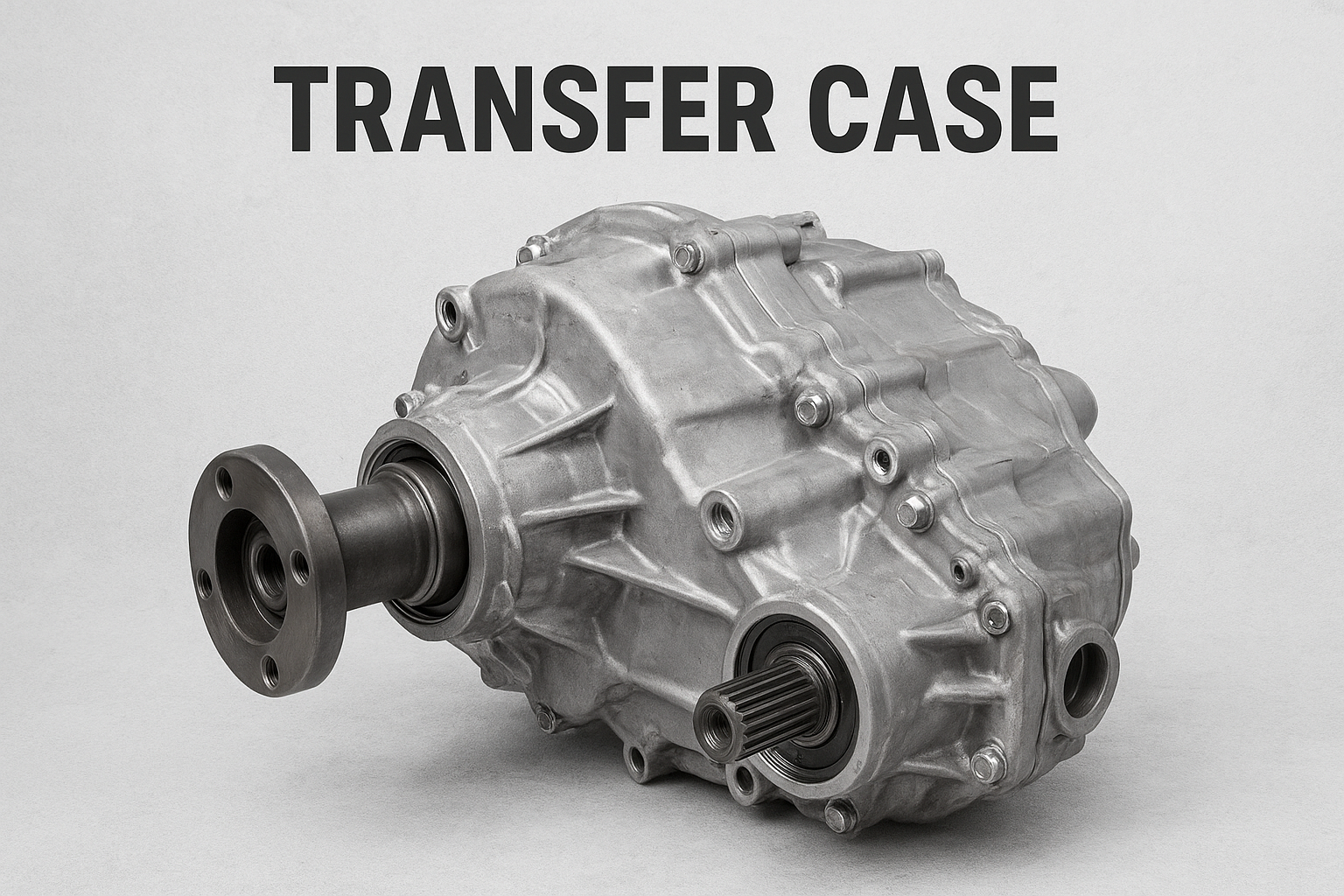Every four-wheel-drive (4WD) and all-wheel-drive (AWD) vehicle relies on an important mechanical part called the transfer case. This component is responsible for distributing power from the transmission to the front and rear axles, ensuring all wheels receive the right amount of torque. While it might sound complex, understanding the transfer case is crucial for anyone who wants to know how their vehicle operates—especially when it comes to off-road driving or slippery conditions.
In this guide, you’ll learn what a transfer case does, how it works, the types available, common issues, and how to maintain it properly. This article uses simple terms so that even a ninth-grader can understand how this vital automotive part functions.
What Is a Transfer Case?
A transfer case is a mechanical gearbox found in vehicles that deliver power to more than one axle. It takes the power coming from the transmission and divides it between the front and rear driveshafts. This ensures that all four wheels can work together, improving traction and control.
In simple terms, if the transmission is the “heart” of the drivetrain, then the transfer case is the “vein” that directs the power flow to the right places. It’s mainly used in four-wheel-drive (4WD) and all-wheel-drive (AWD) vehicles.
How a Transfer Case Works
To understand how a transfer case works, imagine your car’s engine as the source of energy. The transmission controls the amount of power that goes to the drivetrain. Then, the transfer case splits that power between the front and rear axles.
In a 4WD vehicle, the transfer case also allows drivers to choose between different driving modes—such as 2WD (two-wheel drive), 4WD High, and 4WD Low. Each mode changes how the power is distributed, depending on driving conditions.
For instance:
2WD Mode: Power goes only to the rear wheels, improving fuel efficiency.
4WD High Mode: Power is evenly split between front and rear wheels, providing traction on slippery roads.
4WD Low Mode: Extra torque is delivered to all wheels for tough terrain, like mud or steep hills.
Inside the transfer case, a set of gears, chains, and sometimes hydraulic clutches help control this power transfer smoothly.
Types of Transfer Cases
There are two main types of transfer cases: gear-driven and chain-driven. Each has specific advantages and is suited for different driving needs.
Gear-Driven Transfer Case
This type uses solid gears to send power between the axles. It’s extremely strong and durable, making it ideal for heavy-duty trucks or off-road vehicles. However, it can be heavier and noisier than other designs.
Chain-Driven Transfer Case
This version uses a chain to transfer power from one shaft to another. It’s lighter, quieter, and more fuel-efficient. These are commonly found in modern SUVs and light-duty trucks.
In addition to these, there are also manual and automatic transfer cases:
Manual Transfer Case: The driver manually shifts between drive modes using a lever.
Automatic Transfer Case: The system automatically adjusts power between axles based on road conditions.
Why the Transfer Case Matters
The transfer case plays a vital role in ensuring vehicle stability and control, especially in challenging conditions. When driving on slippery, snowy, or uneven roads, it provides balanced power to all wheels. This balance prevents wheel slip and improves traction.
Furthermore, in off-road vehicles, it allows for the use of low-range gears, which increase torque and make it easier to climb steep hills or drive through rough terrain. Without a properly functioning transfer case, a 4WD vehicle loses its ability to handle these challenges safely.
Common Signs of Transfer Case Problems
Like any part of a vehicle, a transfer case can develop issues over time. Recognizing early signs of trouble can save money and prevent accidents.
Here are some common symptoms of a failing transfer case:
Difficulty Shifting Gears: If it’s hard to switch between 2WD and 4WD, internal components may be worn.
Grinding or Unusual Noises: Whining or grinding sounds might mean gears or bearings are damaged.
Fluid Leaks: A puddle of red or brown fluid under your car could indicate a leaking transfer case seal.
Jerky or Uneven Driving: Power not being evenly distributed can cause uneven acceleration or vibrations.
Warning Lights: Many modern vehicles have dashboard lights that alert you to 4WD system issues.
If any of these symptoms appear, it’s best to have a mechanic inspect the system immediately.
Transfer Case Maintenance Tips
Regular maintenance is key to keeping your transfer case in good condition. Proper care ensures it performs efficiently and lasts longer.
Here are some simple maintenance steps:
Check Fluid Levels Regularly: The fluid keeps gears and bearings lubricated, reducing wear.
Change Transfer Case Fluid as Recommended: Most manufacturers suggest replacing it every 30,000 to 60,000 miles.
Inspect for Leaks: Small leaks can lead to bigger problems if ignored.
Use the Right Type of Fluid: Always follow the manufacturer’s recommendation, as the wrong fluid can damage seals and gears.
Engage 4WD Occasionally: Even if you don’t drive off-road often, using 4WD helps keep internal parts lubricated.
By following these tips, you can avoid costly repairs and maintain a smoother drive.
The Role of Transfer Case Fluid
Transfer case fluid acts like blood in the human body—it keeps the system cool, clean, and lubricated. It prevents metal parts from grinding against each other and helps remove heat.
Over time, this fluid can break down or become contaminated with dirt and metal shavings. When that happens, it loses its effectiveness, leading to damage inside the transfer case. Therefore, routine fluid checks and replacements are crucial for keeping everything working properly.
Repairing or Replacing a Transfer Case
Sometimes, even with proper maintenance, a transfer case can fail. When that happens, you’ll need to decide whether to repair or replace it.
Repair: Minor problems, like a bad seal or bearing, can often be repaired without replacing the whole unit.
Rebuild: A rebuild involves replacing worn-out parts inside the case but keeping the main housing.
Replace: In severe cases, a full replacement might be necessary. This is common when internal gears are damaged or the case is cracked.
Replacing a transfer case can be expensive, depending on the vehicle model. That’s why prevention through regular maintenance is always the best approach.
The Difference Between AWD and 4WD Systems
While both AWD and 4WD systems use a transfer case, they work a bit differently.
AWD (All-Wheel Drive): Power is automatically distributed to all four wheels at all times. It’s great for on-road use and light snow conditions.
4WD (Four-Wheel Drive): Power is sent to both axles only when needed. Drivers can manually select 2WD or 4WD modes. It’s better for off-road or heavy-duty use.
The transfer case is the heart of both systems, ensuring smooth coordination between front and rear wheels.
Importance of Proper Use
Even though a transfer case is designed for tough conditions, using it incorrectly can cause damage. Here are a few guidelines:
Do not use 4WD on dry pavement for long periods—it increases stress on the drivetrain.
Always shift modes according to the manufacturer’s instructions.
Slow down when shifting between 4WD High and 4WD Low.
Avoid sudden acceleration or spinning tires when using 4WD Low.
By following these precautions, you help protect both your transfer case and your vehicle’s transmission.
How to Extend the Life of Your Transfer Case
To keep your transfer case functioning for years, make preventive care a habit. Here’s how:
Keep up with oil changes and inspections.
Pay attention to strange sounds or sensations when driving.
Use your vehicle’s driving modes correctly.
Avoid overloading your car, as too much weight can strain the drivetrain.
Get professional servicing at regular intervals.
These habits ensure long-term reliability and safety on the road.
Modern Transfer Case Technology
Today’s vehicles feature advanced transfer cases that combine mechanical precision with electronic control. Many modern systems use sensors to detect wheel slip and adjust torque automatically.
For example, some vehicles employ active transfer cases that change torque distribution in real time. This not only improves traction but also enhances fuel efficiency by sending power only where it’s needed.
In addition, lightweight materials like aluminum are used in newer designs to reduce overall vehicle weight and improve performance.
Conclusion
The transfer case might not be the most talked-about car component, but it’s one of the most important for vehicles with AWD or 4WD systems. It ensures your car can handle tough terrain, maintain traction, and perform efficiently under various conditions.
By understanding how it works and caring for it properly, you can prevent costly repairs and enjoy smoother, safer driving. Regular maintenance, correct usage, and paying attention to early warning signs can make your transfer case last as long as your vehicle.

